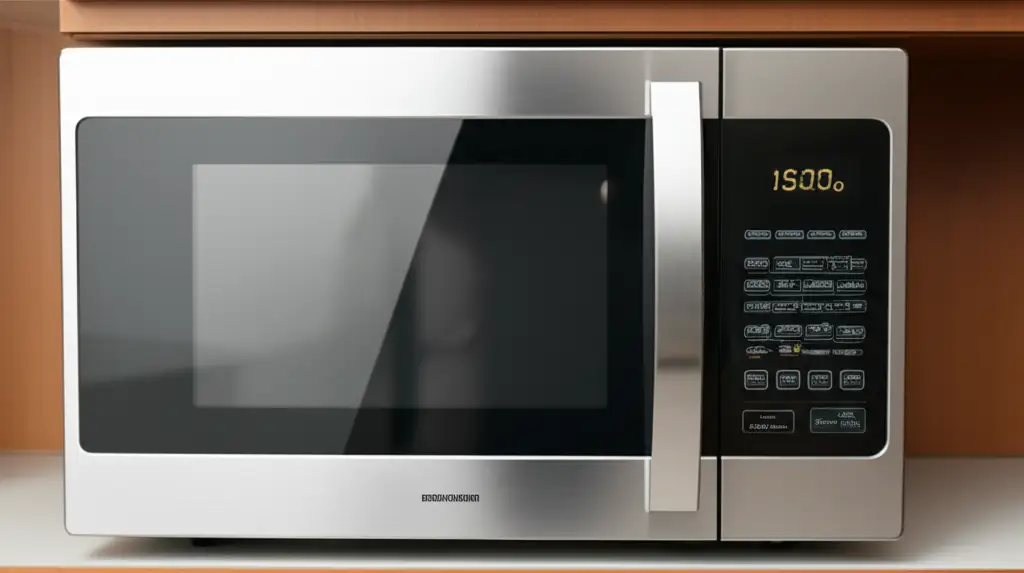· Todd Martin · Kitchen Appliances · 18 min read
Can You Install Over The Range Microwave In Island

Island Microwave Installation: Can You Use an OTR Unit?
Kitchen islands offer great functionality and style. Many homeowners want to maximize their use. Placing appliances like a microwave in an island seems like a smart idea. A common question arises: can you install over the range microwave in island? It is an intriguing thought. Over-the-range (OTR) microwaves are popular for their space-saving design above a stove. However, moving them to an island creates unique challenges. We will explore the feasibility, electrical requirements, ventilation needs, and safety aspects. We will also discuss better alternatives for island microwave placement.
Takeaway
Installing an over-the-range microwave in an island presents several difficulties.
- Ventilation is a major problem: OTR units vent upwards. Island placement requires complex ductwork or relies on less effective recirculation.
- Mounting needs custom solutions: OTR microwaves attach to upper cabinets. Islands require sturdy custom cabinetry to support their weight.
- Safety and usability are compromised: The door opening and height may be awkward. Heat can become an issue.
- Dedicated microwave drawer units are a superior alternative: These appliances are specifically designed for island or lower cabinet installation.
It is generally not recommended due to these challenges. Specialized island microwave options offer better performance and safety.
It is technically possible to install an over-the-range microwave in an island, but it is not ideal. This setup creates significant challenges, especially with ventilation, mounting, and user accessibility. Specialized microwave drawers or built-in models are much better choices for island placement.
Understanding Over-the-Range Microwaves
Over-the-range (OTR) microwaves are a common sight in many kitchens. They combine a microwave oven with a ventilation fan. This design saves counter space by sitting above your stove. Their primary purpose is dual: heating food and venting cooking fumes.
An OTR microwave typically mounts to the underside of an upper kitchen cabinet. It also attaches to the wall behind it. This provides strong support for the unit’s weight. The ventilation system usually offers options for external venting through a duct. It can also recirculate filtered air back into the kitchen. The fan directs smoke and odors upwards from the stovetop. This design makes them very effective in their intended location.
The “over the range” part of the name is key. It defines their function and design. They are made to clear the air directly above a cooking surface. This is why their powerful fans pull air upwards. When you think about moving this appliance, its original purpose becomes important. Placing it in an island changes its environment completely. The way it mounts and the way it vents are designed for a specific overhead location. Using it elsewhere means adapting it significantly. You may wonder, does over-the-range microwave have to be over the range? The answer touches on these design constraints. Their features are specific to this traditional placement. Moving it means those features might not work as intended. For example, their ventilation becomes less effective. They are not built for lower cabinet or island installations. This type of unit is a specific appliance. It has a specific job in a specific place. Using it differently requires understanding its limitations. This is not like a countertop microwave. It is not designed to simply sit anywhere. Considering it for an island means understanding its core functions.
Key Challenges of Island Installation
Installing an over-the-range microwave in a kitchen island presents several significant hurdles. These challenges make it a less than ideal solution. I have seen many kitchen designs, and this is always a complex request.
Ventilation Issues
The biggest challenge is ventilation. Over-the-range microwaves are designed to vent cooking fumes upwards. They pull air from above the stovetop. In an island, there is no stovetop directly above it. There is nothing for the fan to pull fumes from. The unit’s fan becomes largely ineffective for its primary purpose.
- Upward Airflow Design: OTR units pull air upwards. This works for stovetops. In an island, it pulls air from inside the cabinet. This air is not helpful for cooking odors.
- Ducting Complexity: If you try to duct an OTR unit in an island, it needs a complex system. Ducts must run down through the island cabinet. They then go through the floor. They must connect to an exterior wall or roof. This is a very expensive and difficult renovation. It is much harder than a simple wall vent.
- Recirculation Limitations: Many OTR microwaves offer recirculating filters. This option does not remove smoke or odors from the kitchen. It only filters grease and some particles. In an island, this means cooking smells will linger. You will not get true ventilation.
Mounting and Support Requirements
Over-the-range microwaves are heavy. They require strong support. They typically mount to both the underside of an upper cabinet and the wall studs. This provides a stable and secure installation.
- Lack of Upper Cabinet: An island does not have an upper cabinet. This means the primary support point is missing. You cannot mount an OTR unit in the standard way.
- Custom Framing: You would need to build a custom frame inside the island cabinet. This frame must be robust. It must handle the microwave’s weight safely. This adds significant cost and complexity to the island construction.
- Weight Distribution: The weight must be evenly distributed. An OTR unit needs strong anchoring points. If not properly supported, it could sag or even fall. I always advise extreme caution with this. Knowing how to mount over the range microwave without cabinet might give some ideas, but it is a different scenario entirely. That refers to wall mounting, not island base mounting.
Electrical Considerations
All microwaves require a dedicated electrical circuit. This is a crucial safety measure. It prevents tripping breakers and ensures enough power. An island may not have the necessary wiring in place.
- Dedicated Circuit: An OTR microwave needs a 20-amp, 120-volt dedicated circuit. This is often not present in a standard island.
- Wiring Extension: You must run new electrical lines to the island. This means cutting into floors or ceilings. It requires a licensed electrician. This adds significant cost and labor to the project.
- Code Compliance: Electrical work must meet local building codes. Improper wiring is a fire hazard. Always consult a professional. You can read more about this requirement here: does an over-the-range microwave need its own circuit. This is non-negotiable for appliance safety.
Safety and Accessibility Concerns
Placing an OTR microwave in an island also creates safety and usability issues. Its design is for eye-level use.
- Door Swing: OTR microwaves have a side-hinged door. When placed in an island, this door opens downwards into your standing space. This can be awkward. It can also be a tripping hazard.
- Height and Reach: The microwave will be low to the ground. Reaching inside to place or remove hot food can be difficult. It is not comfortable for most adults. It can be especially challenging for children or older family members.
- Heat Dissipation: Microwaves generate heat. OTR units vent some of this heat upwards and out. In an enclosed island cabinet, heat can build up. This affects the appliance’s lifespan. It can also pose a fire risk if not properly managed.
These challenges make installing an over-the-range microwave in an island a complex and often impractical endeavor.
Feasibility: Is It Possible to Install an OTR Microwave in an Island?
Yes, technically, it is possible to install an over-the-range microwave in an island. However, “possible” does not mean “recommended” or “ideal.” It requires extensive modifications and compromises. I would strongly advise considering alternatives first.
You cannot install an OTR microwave in an island using its standard mounting method. Those methods rely on overhead cabinets and wall studs. In an island, you would need to build a custom cabinet enclosure. This enclosure must be extremely strong. It needs to support the weight of the microwave. It also needs to handle the stresses of daily use. Some people explore if can you put an over-the-range microwave in the wall as a built-in. This is a closer concept to an island install. Still, it involves a dedicated space.
The main issue is that OTR microwaves are designed for a specific purpose and location. They are meant to be above a stove. Their ventilation system pulls steam and smoke upwards. When placed in an island, this venting capability is largely lost. You will either have an ineffective recirculating fan or a very expensive ducting project. The microwave itself will still heat food. However, you pay for features you cannot properly use.
Furthermore, the design of an OTR microwave is for eye-level operation. The door often swings out to the side. When placed low in an island, this door can obstruct traffic flow. It forces you to bend down to access the interior. This becomes an ergonomic nightmare. Think about pulling a hot dish out from a low, awkward angle. It increases the risk of spills or burns. While it can be done, the result is often a less functional kitchen. It might also be a less safe one.
Some homeowners might consider this to save money. OTR microwaves can be less expensive than dedicated drawer models. However, the costs of custom cabinetry, electrical work, and ventilation outweigh these savings quickly. The total project cost will likely exceed that of a purpose-built island microwave. The compromises in performance and safety are also significant. Therefore, while physically achievable, it is generally not a smart choice for long-term kitchen functionality. The question of can over-the-range microwave be used as built-in is relevant here. A custom built-in space in an island is essentially making it a built-in. However, the OTR unit’s design makes it a poor fit for this role. It lacks the streamlined look and user-friendly access of true built-in models.
Designing Your Island for a Microwave
If you decide to pursue installing any type of microwave in your kitchen island, careful design is essential. This ensures the appliance fits well and functions properly. The island must accommodate the microwave’s dimensions, electrical needs, and any ventilation.
Custom Cabinetry and Dimensions
A standard base cabinet is usually 24 inches deep. OTR microwaves are often 15-16 inches deep and around 30 inches wide. You need to ensure the cabinet has enough depth. It also needs proper width for the microwave to slide in. More importantly, the cabinet must be custom-built to support the microwave’s weight.
- Structural Support: Unlike a typical shelf, the microwave needs robust support. This means thicker side panels or a reinforced shelf. A dedicated cubby or frame within the cabinet is best.
- Ventilation Space: Even if recirculating, the microwave needs air circulation. Do not build it into an airtight box. Leave space around the unit for heat dissipation. You may need vents or grilles on the cabinet doors or kick plate.
- Door Opening: If using a standard microwave, consider its door swing. A side-opening door will be awkward in a low island position. Drawer microwaves are much better here.
Planning for Electrical and Ventilation
You must plan for power and ventilation early in the design phase. This avoids costly changes later. Integrating these elements seamlessly into the island structure is key.
- Dedicated Outlet: A 20-amp, 120-volt electrical outlet is required. This must be a dedicated circuit from your breaker panel. The outlet should be easily accessible behind the microwave.
- Concealed Wiring: All wiring needs to be hidden within the island. It must comply with electrical codes. This often means running conduit through the floor or inside the island’s frame.
- Ventilation Strategy: If you try to duct an OTR unit, plan the duct path. It will run downwards. It needs to go through the floor and out of your home. This is a major construction task. For simpler options, ensure cabinet design allows for internal air circulation.
Accessibility and Usability
The height and placement affect how easy the microwave is to use. An island microwave is typically lower than a wall-mounted one.
- Optimal Height: For ease of use, a microwave’s bottom should be about 15 inches above the floor. This aligns with standard counter heights. It makes it easy to access food.
- User Comfort: Consider who will use the microwave most often. Is it comfortable for them to bend down? Drawer microwaves pull out, making access easier.
- Clearance: Ensure enough space in front of the island. You need room to stand and open the microwave door fully. Think about other island functions, like seating.
Building a kitchen island from scratch offers many design opportunities. You can integrate appliances like a microwave easily. Resources like how to make a kitchen island out of base cabinets or how to build a kitchen island with stock cabinets provide foundational knowledge for island construction. They might not cover specific microwave integration details for OTR units, but they give a good starting point for the custom work needed. Always prioritize safety and functionality in your design.
Ventilation Solutions for Island Microwaves
Ventilation is one of the most critical aspects when installing any microwave in an island, especially an OTR unit. Traditional OTR microwaves are designed to capture steam and odors from a stovetop directly below them. This upward-pulling design does not work efficiently in an island. My experience shows that this is where most island microwave installations face issues.
Why OTR Venting is Unsuited for Islands
An over-the-range microwave’s fan is located at the top of the unit. It pulls air upwards into its filter system. When this unit is in an island, there is no stovetop above it. The microwave’s fan will simply pull air from inside the island cabinet. It will not capture cooking fumes from your main stove. It becomes an appliance without its primary ventilation function. It is like putting a ceiling fan on the floor. It moves air, but not where it is needed.
Recirculating Ventilation
Most OTR microwaves have a recirculating option. This means air is drawn in, filtered, and then blown back into the room.
- How it works: Grease filters catch oil and food particles. Charcoal filters reduce some odors. The air then re-enters the kitchen through vents on the top front of the microwave.
- Limitations: Recirculating systems do not remove heat or moisture. They do not truly vent smoke or strong cooking odors. They just clean the air a bit. In an island setting, this means the microwave is still adding heat to the cabinet space. It is not helping with general kitchen air quality.
- Maintenance: Filters need regular cleaning or replacement. This is important for optimal performance. You can find guidance on how to clean range hood filter for general filter maintenance.
Ducted Ventilation for Island Microwaves
Ducting an OTR microwave in an island is possible, but it is a major construction project. This is very different from a standard wall-mounted OTR.
- Complex Ductwork: Ducts must run from the top of the microwave. They need to go down through the island structure. Then they must pass through the floor. They continue through a crawl space or basement. Finally, they exit through an exterior wall or the roof. This path is long and complex. It needs careful planning to maintain proper airflow.
- Cost and Labor: This type of ducting is expensive. It involves cutting through flooring and potentially joists. It requires professional installation. This cost often far outweighs any savings from using an OTR unit over a dedicated island microwave.
- Airflow Restrictions: Long or winding ducts reduce fan efficiency. This means the fan works harder. It moves less air. The noise level might increase.
Considering Downdraft Ventilation
Some islands feature cooktops. These often use downdraft ventilation systems. A downdraft fan pulls cooking fumes downwards into a vent. This is different from an OTR microwave. It is important to know that an OTR microwave does not include a downdraft system. You cannot use its fan for this purpose. If you have a cooktop in your island, you need a separate downdraft system for it. An OTR microwave placed near it would still require its own ventilation solution. Or, its internal fan would be redundant.
Comparing an OTR unit with a dedicated range hood shows the difference in function. You can replace an OTR microwave with a proper vent hood above a stove. This is about dedicated ventilation. See how to replace over the range microwave with vent hood for insights into that setup. For an island microwave, the best ventilation comes from units designed for that space, like microwave drawers. These units usually do not need external venting. They use internal recirculating fans.
Electrical Wiring and Safety Considerations
Electrical wiring is a critical component of any appliance installation. When considering an over-the-range microwave for an island, electrical safety becomes even more important. I always stress the need for professional help here. Mistakes in wiring can lead to serious hazards.
Dedicated Circuit Requirement
All microwaves, including OTR units, are high-wattage appliances. They draw a lot of power. Because of this, the National Electrical Code (NEC) requires them to be on a dedicated circuit.
- What it means: A dedicated circuit means the microwave is the only appliance connected to that specific circuit breaker. No other outlets or lights share its power.
- Why it is needed: This prevents circuit overloads. If too many appliances are on one circuit, the breaker will trip. This shuts off power to everything on that circuit. A dedicated circuit ensures the microwave receives stable power. It also reduces the risk of electrical fires. You can learn more about this by reading does an over-the-range microwave need its own circuit. This is a foundational rule for microwave safety.
- Circuit Specifications: An OTR microwave typically needs a 20-amp, 120-volt circuit. The wire gauge must be appropriate for this amperage, usually 12-gauge wire.
Wiring an Island for a Microwave
Adding a microwave to an existing island often means new electrical work. An island might have existing outlets. However, these are usually for general use. They are not likely dedicated circuits for high-power appliances.
- Running New Lines: A licensed electrician must run a new electrical line from your main breaker panel to the island. This usually involves opening walls or floors. They might need to run conduit to protect the wires.
- GFCI Protection: Any outlets in a kitchen island, especially near a sink or water source, typically require Ground Fault Circuit Interrupter (GFCI) protection. This device quickly shuts off power if it detects a ground fault. It prevents electrical shock.
- Concealed Wiring: All wiring must be safely enclosed within the island structure. It should not be exposed. This protects the wires from damage. It also maintains a clean appearance.
Heat Build-up and Ventilation Importance
Microwaves produce heat during operation. In a confined space like an island cabinet, this heat can accumulate. Proper ventilation within the cabinet is crucial, even if the OTR’s fan isn’t venting externally.
- Appliance Lifespan: Excessive heat can shorten the microwave’s life. It can damage internal components over time.
- Fire Risk: Poor heat dissipation can increase fire risk. Trapped heat might overheat wires or components.
- Cabinet Material: Ensure the cabinet materials can withstand minor temperature fluctuations. Good air circulation is the best way to prevent heat issues.
Adhering to Building Codes
All electrical installations must comply with local building codes. These codes exist to ensure safety.
- Permits: Many electrical projects require permits from your local municipality. You might need an inspection after the work is done.
- Professional Installation: Hiring a licensed electrician is always recommended. They know the codes. They ensure safe and compliant wiring. Trying to do complex electrical work yourself is dangerous. It can lead to severe penalties or insurance issues. Issues like why does my over-the-range microwave keep tripping the breaker are often linked to improper wiring or circuit loads. Preventing these issues starts with correct installation.
Prioritizing safety in electrical wiring is paramount for any home project. Never cut corners when it comes to power supply.
Recommended Alternatives to OTR in an Island
Given the significant challenges of installing an over-the-range microwave in an island, I strongly recommend exploring alternatives. These options are specifically designed for island or lower cabinet placement. They offer better functionality, safety, and integration into your kitchen design.
Dedicated Island Microwave Drawers
Microwave drawers are the top choice for island installation. They are specifically engineered for this purpose.
- Design and Functionality: These units pull out like a drawer. You load and unload food from the top. This design is very ergonomic. It avoids awkward bending. The controls are typically on top, angled for easy access.
- Placement Flexibility: They fit seamlessly into base cabinets. They can be placed under a counter, in an island, or even in a pantry.
- Ventilation: Most microwave drawers are self-venting. They use internal fans to recirculate air. They do not require external ducting. This simplifies installation.
- Aesthetics: They offer a sleek, built-in look. They blend beautifully with custom cabinetry. This creates a very clean kitchen design.
- Cost: Microwave drawers are often more expensive than standard countertop or OTR microwaves. However, this upfront cost is usually offset by easier installation. You avoid the custom framing and complex ducting needed for an OTR unit.
Built-in Countertop Microwaves
Another excellent alternative is a standard countertop microwave adapted for built-in installation.
- Trim Kit: These microwaves use a special trim kit. The trim kit frames the microwave. It gives a finished, built-in appearance. It also allows for necessary air circulation around the unit.
- Cabinet Requirement: You need a dedicated cabinet opening for this. The cabinet must be the correct size to fit both the microwave and the trim kit.
- Accessibility: Like microwave drawers, these can be placed at a comfortable height. They can be under the counter, in an island, or even within a wall cabinet.
- Cost-Effective: This option is often more budget-friendly than a microwave drawer. You buy a regular microwave. Then you buy a relatively inexpensive trim kit. This is a great way to achieve a built-in look without the higher cost of a drawer model. The question can over-the-range microwave be used as built-in is relevant here. While an OTR unit can technically be ‘built-in’, a standard microwave with a trim kit is a much better fit for a true built-in look and function.
- Kitchen island microwave
- Microwave installation
- Appliance placement
- Kitchen design
- Ventilation solutions





